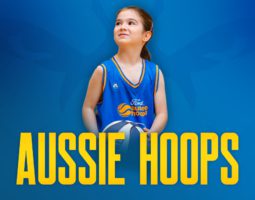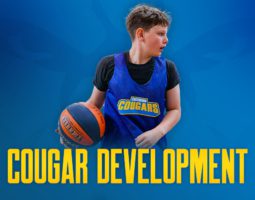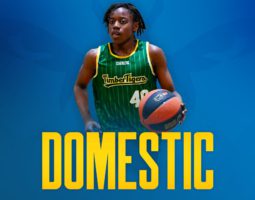If you think of the 50-year history of the Cockburn Basketball Association it’s hard to imagine anyone who has had a more significant impact, or been there for the whole ride quite like Bert de Meyere.
The Cougars legend was there before there even was a Wally Hagan Stadium, in fact he was instrumental in it being built and expanded. He was there before there even was an organised basketball competition in actual fact.
And over the past 50 years, his passion for and commitment to the Cockburn Basketball Association has been remarkable.
Rather than us talk about him, why don’t we sit back and let him share the story of the history of basketball in Cockburn, his own journey, what it means to him and some fascinating stories along the way.
Enjoy this history lesson!
THE BEGINNING
It’s been 50 years of my life basically, even though the last couple of years have been a bit less. We started off in 1972 and I still remember how it all came about when we had a meeting with a few of the guys at the Phoenix Hotel which no longer exists. I had been playing basketball with Fremantle Churches of Christ down at the Showgrounds and Perry Lakes at one stage so I’d been playing the game for a little bit. The question came up while I was at work at the port authority because I knew a bit about basketball and they wanted to start up a local association. They were playing women’s basketball and junior girls at the YMCA in Fremantle and the decision was made by them to actually form an association and get men’s teams going as well.
They approached Fremantle and they wouldn’t have a bar of it so instead they approached the City of Cockburn because they had a couple of netball courts down at Bakers Square. There was enough room to chuck another couple courts on there which could become basketball courts. They were pretty happy with that so the Cockburn Basketball Association was formed by the end of 1972 and we moved down there to Bakers Square.
We had the opening ceremony in October for the start of the new season and there obviously had been a fair bit groundwork done to get to that point. We separated the running of the men’s division and the women’s division, and I became the secretary of the men’s division pretty much from the first meeting and it continued on to get both competitions going. We didn’t worry too much about juniors going at this stage, but we had those two courts at Bakers Square and we had two divisions in the men, and two divisions in the women. The women played on Tuesday night and the men on Thursday night, so that’s how it all started.
It continued to grow from there. The next thing was creating the winter competition. Bakers Square was obviously open air so at the end of the summer season, everyone said we’d see you in the winter. But then we came back and said, “What do you mean? We can’t play in winter because we’d get rained out.” I had been playing at Perry Lakes which was originally played out of the Centenary Pavilion at the Showgrounds before they shifted to a different pavilion which had been used for tennis. They decided to put four basketball courts there and it was an indoor competition in the winter, which was good. I knew that was there and had been playing at Churches of Christ as well so I knew winter basketball would be popular, so I decided to go down to Claremont and hire out the pavilion so we could play our competition in the winter. It was OK by them for us to use it, Churches of Christ were fine with it too and so was the equivalent of BWA.
There was a modest charge for us of the court and backboards, so that was our first winter comp which was a bit smaller than the summer one but it was good because of the better facilities. Some of our clocks didn’t work properly and everything. Some games would just keep going for a couple of hours until everyone would foul out, or we had to go home. As well as playing, I was doing the scoring for some games and refereeing the others. Everyone just had to come in, put their 20 cents on the desk and they were good to go. The only problem we had was that the roof leaked a bit there at Claremont at times and we had to get out by a certain time before the Royal Show started which meant the schedule could become a bit tight. There was even a circus there one time and we had to sweep up after the elephants before we could play basketball. These were the good old days and things like that would always happen.
THE CREATION OF WALLY HAGAN STADIUM
Bakers Square was quite busy by that stage and we talked the council into taking the two netball courts and making them dual use so we could play basketball on there as well. Netball was only using them for training but they were very possessive of the courts and didn’t really want these basketball guys in there, but eventually they gave in and we had a sort of friendly relationship with them in the end. We couldn’t trespass on their time or anything through. That was basically the first seven years playing outdoors before we got the stadium built and open.
But as soon as we got a taste of indoor basketball that’s when the idea of building our own stadium was born. We had to go back to playing outside for a while until it all happened and we did that in the summer at Bakers Field, but we quickly got some engineers involved and Rick Longley got involved with it. There was one particular guy who was in the club coaching a girls’ team and playing as well, and he was an engineer and these were all young blokes. At 30, I was the oldest guy there and when we finally got around to building the stadium many a day you could see him on the roof making sure everything was being done properly.
The stadium got some momentum so we went out and got some quotes. We approached the council with Wally Hagan the main one we dealt with and the mayors were always good with us. They supported us quite a bit but in the first instance, they said they were building another venue at Joe Cooper Reserve. They could only guarantee us one indoor court and a few outdoor ones, which wasn’t really what we were looking for but we couldn’t look a gift horse in the mouth. But then the people who lived around there said they didn’t want a basketball stadium in front of their place.
So it wasn’t going to be built there and they had to come up with another spot for it, and all we were asking for was something of a decent size with four walls and a roof, a floor of some sort and some backboards. We eventually settled on the site and then it was a question of money. They could get us two $100,000 loans but we needed to support those loans and show we could repay it with interest. We thought we could do that, $200,000 for a stadium sounded all right, and then we went down and met with the council and their finance people at the old council chambers in Forrest Road. We were talking to Rick Longley and we had to convince them that we could do it for $200,000 but he said it would cost $350,000 at least. But I said we just had to compromise and maybe we couldn’t have everything we wanted, but we went back and said we could get it built for $200,000 and we got going with it.
They had to take some land that was a bit of road reserve there and they couldn’t encroach too far on the oval because it was granted land for local residents. That stayed for a while but the original plan of the stadium was in three stages: the first one was for four courts; the second one was another four courts on the far side; and then the third one was the swimming pool and gymnasium on the oval side. They gave us the whole area of what we were entitled to and the stadium got done, and we had got what we wanted basically at least for the $200,000.
It was pretty basic and the floors were rubberised bitumen and the thing with the council was that they wanted it to be multipurpose, but they gave us the right to manage it all and to make sure basketball had first priority. To us, that was a good deal and it was something that nobody else had. It was the first stadium outside of what Perry Lakes had so it was a pretty big deal for us to get our own venue.
We had an opening ceremony at Bakers Square with the mayor and all the other dignitaries there so it was good. In those days, we also had people like Ernie Dingo who was playing with us at the time and so was Dick Walley. We also had the East Fremantle Football Club playing with us for a while, South Fremantle put teams in as well and I remember Colin Beard putting me on the bench a few times with a good hip and shoulder. These things don’t happen anymore but they were good experiences at the time, and everyone pretty much enjoyed it.
The floors were green and had multi markings on them for different sports, including tennis. It’s hard to imagine now, but we had tennis played in the stadium and it was usually Perth Tennis Club asking to use our stadium when it was raining and they couldn’t play outside. I’d go down and open it up for them, leave them to it and then come back to close it up. They were quite happy to do that for a number of years but when we went to the wooden floors that wasn’t possible anymore.
EARLY YEARS OF THE STADIUM
When we first opened the stadium it was still mostly a social competition we held and because we had one of the only stadiums around, the influx to Cockburn was tremendous. When we opened the stadium, we had 160 senior teams playing, men and women, and they played four nights of the week until about 11 o’clock. The juniors used to take up all day Saturday and we had a bit of time on Sunday for training, but that’s how things ran at the start of it.
That had already increased significantly from the 30 teams that we started with because we got the other two courts going so we had a bit more room to accommodate them. We ended up with an overflow and then we had another competition up and going on Wednesday. We had one team who could only play on a Monday night so one team had to always play against them each week, and it just grew from there and having our own stadium made it all possible.
There was a big growth period immediately and we had juniors and senior teams coming from Mandurah to play on a Friday night or across the weekends. We had teams from Perry Lakes, teams from all over the place because we had the biggest and best stadium in Perth with the most courts available. We even had the Ellis brothers come down and play with us so we had a good A-grade competition for quite some time.
But really, it was just amazing to see the whole association grow so rapidly and there were so many people involved in getting that stadium up. The contribution that the council made at that time was tremendous. We used to do a bit of door knocking for Wally Hagan and not much else, but basically the support was there for a long time and they managed to pay for the upkeep of the stadium and everything else. There comes a time when you haven’t quite got those funds and the council would step in and write off certain things to help us out.
WOODEN FLOORS
Then came the time for the wooden floors. We thought we would build another two courts out the back with one wooden floor at least but it was just going to cost us so much money. The number of teams by that stage had scaled down a bit because other stadiums around Perth were going up and our teams were joining up at venues closer to home. The first one was up at Wanneroo after ours and then you got Rockingham and Willetton, and Lakeside started up so we were losing quite a few of our teams to those associations. That was to be expected so we did the sums for the new courts with wooden floor and I was still on the board at the time, and it just wasn’t stacking up.
We knew we had to raise money to be able to do it and it was going to mean we needed another $200,000 just to put on another couple of courts. That was going to be difficult for us to raise that sort of money so I suggested just putting in a wooden floor on Court 1. That was going to be $50,000 and we thought we could do that. We called around for quotes all over the place locally, but it was just too expensive so we looked to the eastern states and we ended up going with someone from Queensland.
The quote they gave was by far the best offer and they were going to bring their own timber and team to build it. They could stay at the Hammy and stay for a couple of weeks, and still get it all done for much cheaper than anyone locally could. We ended up getting the timber sent over from South Australia because it was a bit closer and cheaper. It was Tasmanian Oak I think and it ended up being the best floor in the state, and it always has been. It’s now lasted all that time and it was worth the investment and effort that went into it.
THE NEXT UPGRADE
Then somewhere about 30 years ago, the government decided to give us some money if we had plans for improvements on the stadium. It just happened that we were already working on plans to replace the shed that was our office on top of the canteen with something that was a bit more solid and useable. We had plans for clubrooms and so on, and put them in and we ended up having that accepted.
Now at that stage, I actually ended up with an infection in my back and I was in hospital and I was going to be there for at least a month. The decision had already been made for the upgrades and I think it ended up costing the council and government a total of $600,000 to build the structure that’s presently there to this day with the club rooms and so on.
I was in hospital while all that was happening and I think some people thought I was dying, but I knew I wasn’t. And while I was there, they decided to name one of the grandstands after me and to me that was quite a highlight because there are so many people over the years who could have deserved that honour. There’s always been that family feeling around the club and the respect everyone has for everybody else involved.
STORIES THAT STICK OUT
I remember listening to a South Fremantle WAFL game on the radio one day in those days and the commentators mentioned that they have such good ball control that they are like a team of basketballers. Little did they know that they had a team playing down in our competition so that was fun having people like that involved.
Mind you, we did have the odd problem along the way and I think we had 200 judiciary hearings in the first 20 years when I was on the board. I was the secretary of the judiciary panel as well so that could be interesting. We still even have one person suspended to this day for what he did.
There was even a day when a plane crashed through the roof of the stadium. It was on a Saturday and I was down at the stadium for something and then heard this big crash and some bloke came running around and said that his model plane has just crashed through the roof and he wanted to know how he could get up there. So I pointed to where the ladder was and told him to help himself because I wasn’t going up there. The insurance company got a bit of a fright when I told them a plane had crashed through the roof, but that all got sorted in the end and he had to cover his own insurance.
Another highlight speaking of the roof, is when the leaky roof finally got fixed and that only happened fairly recently. It’s only just been overcome not so long ago.
The legend has it that I actually scored the first three-pointer in the stadium and I won’t let anyone say otherwise. The lines had been put in and it was the start of a new competition on Court 3 with a 6 o’clock game. I just happened to be on this side of the centre line and one of the players was cutting to the keyway and he looked up and saw the ball coming. My pass was a bit high for him and instead it went straight into the basket and was counted as a three-pointer so I’ll always claim that.
There was also a time when somebody just moved into a house in the vicinity of the stadium and he would complain about the whistles going until 11 o’clock every night. The council checked it out and we ended up having to soundproof the end wall and take all the fence out and everything just because of him. That same bloke complained to the council that the paper man was delivering the newspaper too early and would wake him up in the morning so he was quite the character.
THE CONTINUED GROWTH
From there we got involved more with things like WABL and the SBL and so on. It always kept growing in different ways and a lot of people were interested in doing that. It wasn’t necessarily my priority because having been there from the start, the priority was always to get the seniors going, getting the juniors involved and sort of build from there. WABL then went well to provide a place for the juniors to go and I got involved in court management so I spent a lot of time doing that. We still had a good senior competition that kept going and it’s still going to this day.
That growth in WABL even if we weren’t winning every game, we were winning a lot of games and were competitive right through all the age groups and grades. And then in the SBL, we’ve won a few championships along the way even if it took a long time to string some together, but it was there and we’ve had a lot of incredible teams and players along the way. Winning those championships has been one of my great highlights and they were always fun to celebrate because you know how much efforts goes into achieving that success.
BERT’S INVOLVEMENT AND DIFFERENT ROLES
By the time we had the first AGM involving all the combined clubs, I ended up getting elected as the overall secretary of the Cockburn Basketball Association. We had an executive committee for the different groups, but we brought them altogether and that’s how we became one association with one committee running it. The committee used to meet every Sunday morning and we had a little hut there at Bakers Square where we’d get together.
The vets competition got going as well and I got involved in that, and it’s still going now as well. I think even Dick Walley is still playing down there. We haven’t seen Ernie come back down yet, but wherever he is I think he’s still playing. In terms of the vets, I was playing when I was 50 and you can still be giving away 15 years to some of the guys so it can get a bit scary but it was all good fun.
In terms of my role at the club, I’ve basically been an administrator for a lot of the 50 years and I’ve been a CPA for 50 years now as well so that’s what my background is. There were just good people involved right from the start and those first seven years, and seeing the growth of that at Bakers Field was a lot of fun to be part of.
There’s been a lot of fun times as well. After I had my operation on my back, I wasn’t allowed to play sport anymore and couldn’t run or jump or anything, which was fine. I was still fine to walk around so instead of refereeing I became court manager and that started about 30 years ago now. It was just after I turned 50 and now I’m nearly 80. I spent more time on court managing than anything else in the end. It still meant I was down there two, three or four nights a week sometimes and fortunately my wife used to go to bed reasonably so she was asleep by the time I got home.
I was a night owl because for a number of years there the fixtures needed to be done, the grading had to be done and it was my responsibility. That’s all the normal stuff when you are setting up a competition and it needed to be done urgently before the season could start. So I could be up working on that until one or two o’clock most nights there for a while until they got done and we had to use pen and paper back then. Computers for that sort of thing hadn’t been invented yet, but that developed and grew over time and they ended up bringing in an administrator so there was no more need to have a secretary so I took that that opportunity to get off the board after about the first 20 years. I wasn’t needed to the same degree so I got off the board, but continued with all my other responsibilities and was still playing and refereeing.
WHAT COCKBURN MEANS TO HIM
Well it goes without saying really how big of a part in my life it’s played. I don’t think my kids suffered at all because of my involvement. I’ve got three girls and they all played down at the stadium at one point or another. My middle daughter is the only girl who has actually played in a men’s team at Cockburn as well. One of the teams was a bit short one day and didn’t want to forfeit, and this was when she was 14 or 15 and in the under-16s she played with the boys. She wasn’t a bad player really so she went out there and it was a riot when the other team complained afterwards because she played well and helped her team win.
When you spend as much time down there as I did, you do your best to keep everything running as smoothly as possible. We even opened up a sports shop at one stage but we were finding more empty boxes than we could find shoes in the end, and it was on consignment so we did away with trying to make a go of that.
We were involved in the canteen on and off as well with different contracts and staff. Even going way back, we’d run the car park before that got sorted and it was very much a family thing. In those older days, we’d have the end of season windups and all that down at the Centenary Hall down the road so that was always a good time.
FINAL THOUGHTS
One of the biggest recent developments at the club was the change in the board and the eventual appointment of Ty to be the general manager. There were a few problems with the board and I got back involved to help sort some of the things out, and we managed to do that. I stayed on the board for another couple of years after that again as treasurer, but the board started as a representative committee and most of the teams weren’t that interested in the administration side of things.
Everybody had a portfolio back then on the committee with somebody doing juniors, somebody doing seniors and then you had a treasurer, secretary, vice-president and president. You then had someone with the SBL portfolio, someone on WABL and these things were added over time. That made things very limited with what you could do and a lot of the people did understand basketball, but you also needed other disciplines on there. You needed people that knew about finance, public relations, advertising and all that sort of stuff which we hadn’t really had.
We always had people involved from within and most of our presidents came from within and there was only one who didn’t show up for a meeting, and he didn’t last too long. But then Ty came along and he wanted to be the general manager after he had been on the board for a little while.
We had some interviews for that general manager position, but instantly I thought that Ty was the ideal person for the role and it was important for the club to create that position. We were still doing all these portfolios for people on the board, but then things changed and we still had basketball people on the board but people with different disciplines as well and we were still trying to pigeonhole everything, and have defined roles. I suggested we should have won person to oversee the whole running of the club and I think that has turned out for the best with Ty in that role.
I think personally, one of the highlights for me is that at the end of all this we’ve got now a viable family-oriented sports club that is respected and I think a lot of times in the old days were the destination club for a lot of people. In the end, we are still there now and still thriving as an association. We are still viable and we still have a stadium, and there has been a bit of talk about the stadium getting a major makeover or even a replacement with the council budgeting for it. It hasn’t happened yet but I believe it’s still on the agenda and I think that’s the thing that we are looking forward to now. A nice new stadium and it might not have all the bells and whistles like we planned in the first place, but it will be right up there and that’s the next thing to look forward to.














